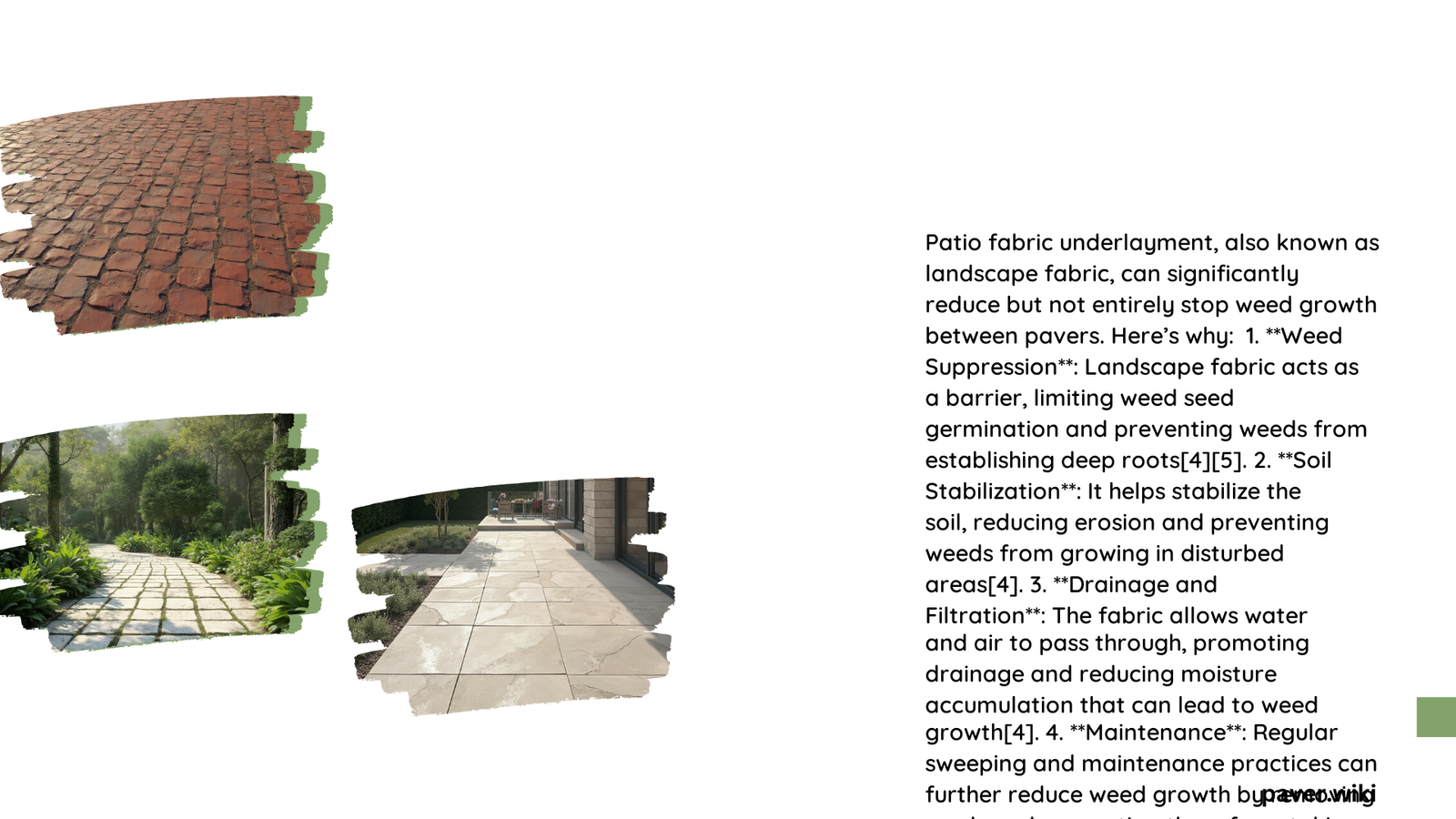Patio fabric underlayment is a popular solution for preventing weed growth between pavers. While it can significantly reduce weed emergence, it does not completely eliminate the problem. The effectiveness of fabric underlayment depends on various factors, including proper installation, quality of the material, and ongoing maintenance. This article explores the efficacy of patio fabric underlayment in controlling weed growth between pavers and provides insights into its properties, installation techniques, and long-term performance.
What Is Patio Fabric Underlayment?
Patio fabric underlayment, also known as landscape fabric or weed barrier, is a synthetic material designed to suppress weed growth while allowing water and nutrients to pass through. It is typically made from polypropylene, polyester, or linen fibers and comes in woven or non-woven varieties.
What Are the Types of Patio Fabric Underlayment?
- Woven Fabric
- Made from polypropylene or linen fibers
- Features a tight weave with small holes
-
Allows water and air to seep through
-
Non-Woven (Spun) Fabric
- Composed of bonded polyester fibers
- More durable and resistant to tearing
- Provides better weed suppression
How Effective Is Patio Fabric Underlayment in Preventing Weed Growth?

While patio fabric underlayment can significantly reduce weed growth between pavers, it is not a foolproof solution. Its effectiveness depends on several factors:
- Quality of the fabric: Higher-quality, heavier fabrics tend to perform better.
- Proper installation: Correct placement and overlap are crucial for optimal performance.
- Maintenance: Regular inspection and addressing any damage promptly can extend its effectiveness.
What Are the Limitations of Patio Fabric Underlayment?
- Does not prevent airborne weed seeds from germinating on top of the fabric
- May degrade over time, especially if exposed to sunlight
- Can be penetrated by aggressive weed roots in some cases
How Should Patio Fabric Underlayment Be Installed for Maximum Effectiveness?
Proper installation is key to maximizing the weed prevention capabilities of patio fabric underlayment. Follow these steps for best results:
- Prepare the area: Remove existing weeds and level the soil.
- Lay the fabric: Place it directly on the prepared soil surface.
- Overlap edges: Ensure a 6-12 inch overlap between fabric sheets.
- Secure the fabric: Use landscape staples or pins to hold it in place.
- Add gravel layer: Place a layer of gravel or sand over the fabric.
- Install pavers: Carefully lay pavers on top of the gravel layer.
What Are the Best Practices for Long-Term Maintenance?
- Regularly inspect the fabric for tears or damage
- Address any exposed areas promptly
- Remove any weeds that manage to grow through or on top of the fabric
- Avoid disturbing the fabric when maintaining the paver surface
What Are the Pros and Cons of Using Patio Fabric Underlayment?
| Pros | Cons |
|---|---|
| Reduces weed growth | Does not eliminate all weeds |
| Allows water and nutrient penetration | Can degrade over time |
| Helps maintain paver stability | May interfere with soil ecology |
| Easy to install | Initial cost can be high for quality fabric |
| Can last several years with proper care | Difficult to remove if needed |
How Does the Cost of Patio Fabric Underlayment Compare to Other Weed Control Methods?
The cost of patio fabric underlayment can vary depending on the quality and type of fabric chosen. Here’s a comparison of different weed control methods:
- Patio Fabric Underlayment
- Cost: $0.50 to $2.00 per square foot
-
Longevity: 5-20 years with proper installation and maintenance
-
Chemical Herbicides
- Cost: $20-$50 per gallon (covers approximately 1,000 square feet)
-
Longevity: Requires regular reapplication, typically several times per year
-
Manual Weeding
- Cost: Time-intensive, potentially free if done by the homeowner
-
Longevity: Ongoing maintenance required
-
Organic Mulch
- Cost: $20-$100 per cubic yard (covers approximately 100 square feet at 3-inch depth)
- Longevity: Needs replenishment every 1-2 years
While the initial cost of quality patio fabric underlayment may be higher, its long-term effectiveness and reduced maintenance requirements can make it a cost-effective choice for many homeowners.
What Are the Environmental Considerations of Using Patio Fabric Underlayment?
When considering the use of patio fabric underlayment, it’s important to weigh the environmental impacts:
- Reduced herbicide use: Fabric can decrease the need for chemical weed control methods.
- Soil health: May impact soil ecology by limiting organic matter decomposition.
- Water conservation: Can help retain soil moisture, reducing water needs.
- Disposal concerns: Non-biodegradable fabrics contribute to landfill waste at the end of their lifecycle.
How Does Patio Fabric Underlayment Perform in Different Climate Conditions?
The effectiveness of patio fabric underlayment can vary depending on the climate:
- Hot, dry climates: Generally performs well, as fewer weeds tend to grow in these conditions.
- Humid, tropical climates: May face challenges with aggressive weed growth and faster degradation.
- Freeze-thaw cycles: Can cause shifting that may damage or expose the fabric over time.
What Are the Alternatives to Patio Fabric Underlayment for Weed Control?
For those seeking alternatives to patio fabric underlayment, consider these options:
- Polymeric sand: Fills paver joints and hardens to prevent weed growth.
- Concrete base: Provides a solid foundation that inhibits weed growth.
- Regular maintenance: Frequent sweeping and spot-treating of weeds.
- Natural weed suppressants: Using materials like corn gluten meal or vinegar.
In conclusion, while patio fabric underlayment can significantly reduce weed growth between pavers, it is not a complete solution. Its effectiveness depends on proper installation, quality of materials, and ongoing maintenance. Homeowners should weigh the pros and cons, consider their specific needs and environmental conditions, and potentially combine methods for optimal weed control in their paver installations.
References:
1. Landscape fabric stone patios and weeds – Devine Escapes
2. Landscape Fabric Types and How to Use Them [Guide] – LawnStarter
3. Weed Barrier Fabric or Weed Barrier Cloth? Does it work? – Mike’s Backyard Nursery
